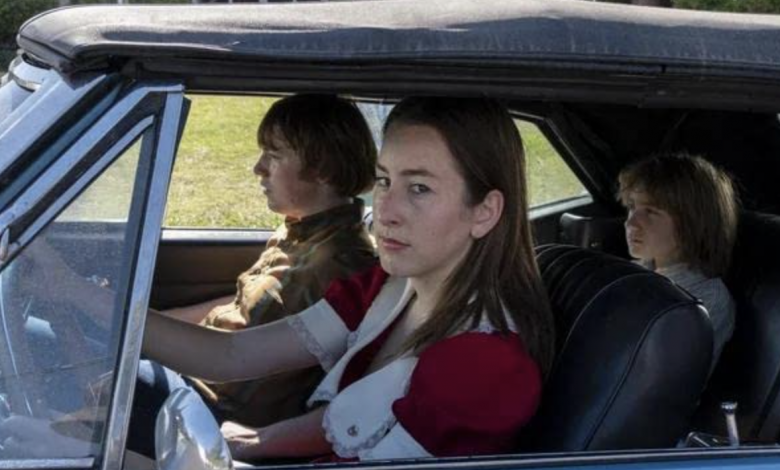Licorice Pizza – The Best, and Worst, of the 1970s

Nikki Emma ’25 / Emertainment Monthly Staff Writer
Licorice Pizza, the latest film by director Paul Thomas Anderson, accurately brings to life the most fondly remembered and the most highly criticized aspects of the 1970s. The film follows Gary Valentine (Cooper Hoffman), a highly successful child star, who is now fifteen and seeking other business opportunities. He does what any young entrepreneur of the time would, he starts a company called Soggy Bottom where he sells waterbeds. Eventually, Alana Kane (Alana Haim), a twenty-something-year-old who first met Gary while working his high school’s picture day, gets involved in the company. Throughout the course of the film, the relationship between Gary and Alana develops alongside an overarching plot revolving around their business ventures. The film itself is extremely fun and enjoyable and most of the comedy is fantastic.
By far the best aspect of the film’s comedy comes from the performances put forth by Alana Haim and Cooper Hoffman. Both first-time actors, the two are perfect choices for their respective characters. Haim’s delivery in particular is fantastic. The film relies heavily on an awkward sense of humor with many of the funniest bits involving characters reacting to one another. Her line delivery provided her costars with opportunities to visually build upon a specific joke. Hoffman as well is really excellent, perfectly encapsulating the energy of a fifteen-year-old boy. A scene involving Maya Rudolph is one of his best, where he hilariously depicts Gary’s complete lack of situational awareness. This visual comedy of characters reacting to the dialogue of others is also at its best in this scene with Rudolph hilariously adding onto Gary’s awkwardness.
The film, which was shot using 1970s processes such as 35mm film, perfectly encapsulates the energy of the time period. The usage of film, in particular, makes the movie feel like it was actually created at the time. A lot of shots also have a very intimate almost, “home movie,” feel to them which also contributes to this nostalgic feel. The production and costume design is fantastic and also perfectly encapsulates the time period. From the opening scene of the film, it is abundantly clear that a lot of thought was put into the costume design for every single person on screen. This film is also unique because it is enjoyable and provides a sense of nostalgia for people of all ages, those who have lived through the 1970s and those who have not.
Anderson spoke in more depth about this process in a recent college roundtable discussion. In response to a question from Emertainment Monthly about whether he faced any specific challenges from this method. Anderson stated, “It did and it didn’t because we shot on film and we’ve been shooting on film for as long as I’ve been making films so the technical challenge for me would have been to have not shot on film because I don’t know how to do that. We have a whole infrastructure in place that was built around how we do it whether we are shooting a music video for Haim or Radio head or something like this project. So the machinery that it takes to do this is stuff, we work with all the time. That said there were a couple of things that we wanted to do. There’s an old light, it’s called an arc light, it is literally a carbon arc. This would be like resurrecting an old 57 Chevy Belair that had been sitting in a garage for thirty or forty years that had never been turned on again and trying to fire it up having it run the Indy 500. Well that’s what using a carbon arc was like and it gives you a quality of light that’s absolutely incredible. Finding the carbon arcs was hard, finding people that knew how to work the light was very hard. They’re very very large, they’re very impractical, they take a lot of power. That was technically something that was very challenging but absolutely worth it once you’ve got these lights turned on. It was one of those magical things where you realize through the labor of it, you realize where no one does it anymore but when you see the quality of light coming out of these lamps you thought how could anybody not go through the pain of getting this light turned on, it’s completely worth it.” The lighting in this film in particular helps a lot in regards to capturing the energy of the time period and it is clear to audiences that Anderon’s struggle was beneficial in the finished film.
Visually, the film also uses a lot of tracking shots. The opening scene appears almost entirely in one take and it very effectively grasps the audience’s attention immediately. The most impressive tracking shot, however, comes from a scene where Gary runs through the streets of San Fernando as David Bowie’s “Life on Mars” plays. This scene is one of the most memorable of the entire film and the tracking shot used for it is beautiful.
While this film is generally fantastic, it does send some strange and somewhat problematic messages. There are several gags and plot points with racist undertones and inappropriate age gaps. It seems like Anderson was making an attempt at satirizing these elements that were accurate of 1970s society, however, it is not always effective. Some of the jokes come across as racist themselves rather than mocking those who perpetrated racist behavior. Furthermore, the outright creepy age gaps also serve as a harsh reminder of reality during the time. However, the film never really seems to criticize these issues, rather showcasing these subjects and leaving their moral implications open for audience interpretation. Despite these problematic tendencies, this film is still an enjoyable watch and one of the best to come out in 2021.